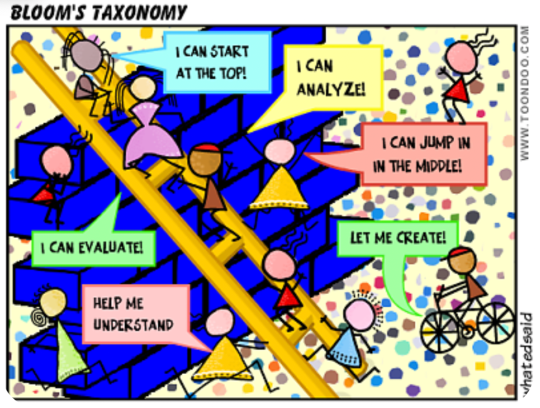Learning isn’t linear. It’s not a step by step, one size fits all process. It doesn’t go in a sequence from remembering to understanding to analysing… and finish with creating. It depends on the learner and on the situation. I think it should look more like this…


I never understood the Bloom’s Taxonomy pyramid as linear. I always thought of it more as reflecting the difficulty of the type of question and the amount of information needed to base that level of question on. To me, there is a danger at jumping in at the evaluation stage. I have seen a lot of GT students who blithely evaluate something about which they know nothing and then think that they have done all the work that that question requires. “Which is more important X or Y?” “Y for sure, because it is cool!” Said and done.
LikeLike
Hi Laura,
I sometimes deliberately oversimplify to make a point or to provoke thinking…
Edna
LikeLike
Mission accomplished! You oversimplified!
LikeLike
That is why we have teacher/facilitators to help guide the process.
LikeLike
I could not agree more! When Bloom and Co. originally started talking about levels of thinking, I don’t believe it was their intention for it to become a linear, step-by-step process, but that is how it was interpreted. I tend to think of Bloom’s taxonomy as a big circle with lines running between each of the “levels” of thinking. As we work, we weave through all the levels of thinking.
LikeLike
Thanks Leslie. I like to think of all learning models in that way. At my school we like Kathy Short’s inquiry model. It’s cyclical with arrows moving back and forth… And I still think it needs arrows drawn across the middle too!
LikeLike
You are right, Edna. We have to get away from the assembly line and into a stewpot.
LikeLike
Stewpot! Let me think about that metaphor a bit … 🙂
Maybe I’ll ask some students ‘How is learning like a stewpot’?
LikeLike
Yep; I like that one. The one I like better (why I named this blog what I did, and the working title for a new book), is a pond. If you go back to my post entitled “Welcome to the Cognitasphere” I think you will see from where those images arise. But for little kids, yep, stewpot is a good one! Thanks for the comment!
LikeLike
I think learning can have both linear and non-linear aspects. As you said, it depends on the learner.
LikeLike
The constant question: Have all the students learned the objective? If not, what else can I try? If learning were linear, all my students would learn all lessons the first time :).
LikeLike
Reblogged this on Alxbal and commented:
Now. That makes a lot of sense…
LikeLike
Edna,
Once again we are thinking along the same lines…can you believe it that y teacher trainees this semester are in process right now of applying the taxonomy in an activity? I am happy to be able to share your blogpost again!
Thanks, Ellen
LikeLike
YES! YES! YES!
nor is it one-way or two-way. it’s multi-way.
love this.
LikeLike
oh, and my newest blog post is along similar lines.
Not Much – what do you say when a student says that he/she has learned nothing or not much?
LikeLike
Reblogged this on Tommy found a real book. and commented:
Great post and visual Of the nOn-linearity of learning.
LikeLike
Reblogged this on STEM – ROBOTICS EDUCATION.
LikeLike
Thanks as always, Edna! I have been absolutely inspired by your blog through the years! I hope you don’t mind that I reference it like crazy–both in my discussions with fellow teachers/admin at my school and on an educational blog to which I contribute (you’re probably seeing several “pingbacks” from where I reference your articles)!! As a PYP 5th grade teacher, I was thinking about flipped classrooms’ effect on inquiry-based learning in the classroom, and its potential to increase direct instruction. On the one hand, flipping the classroom so that instruction takes place at home may provide more room for inquiry learning in class. However, I worry that there’s not much option for the homework to be anything but direct-instruction as students mainly watch videos. Do you have any insights on this matter?
LikeLike